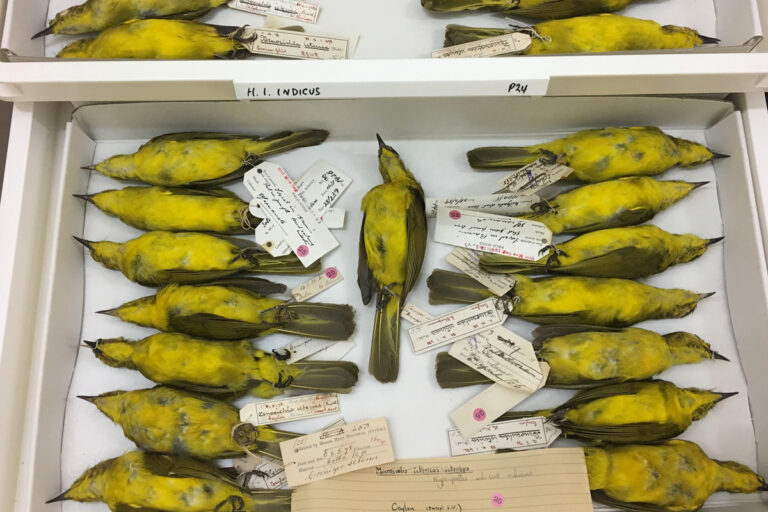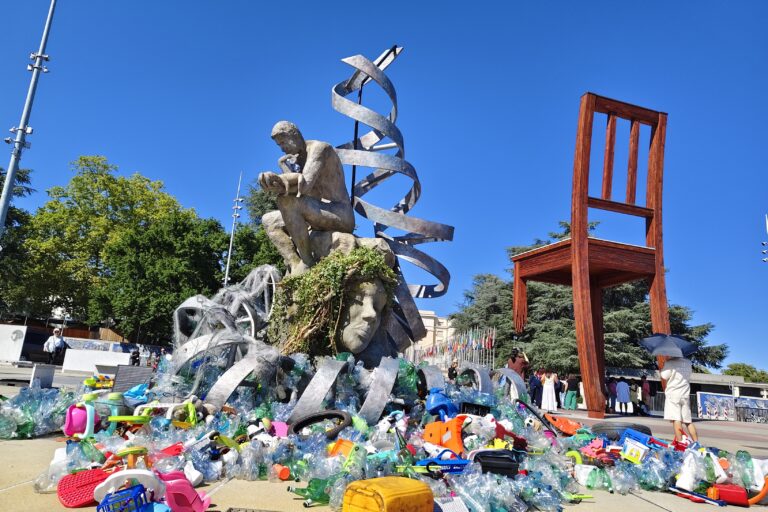- Steven Hamburg spent over six years building MethaneSAT, a satellite that provides free worldwide methane emission data, starting wtih a global database of oil and gas infrastructure.
- India is the fourth largest contributor of methane, a potent greenhouse gas and the second-largest contributor to climate warming after carbon dioxide.
- Once emitted, methane stays in the atmosphere for a shorter lifetime than carbon dioxide, but is 28 times as potent at trapping heat in the atmosphere.
The approach to reducing methane emissions from fossil-fuel operations should be as rigorous as the airline industry’s investigative and data-based approach to eliminating flight risks, according to Steven Hamburg, a scientist who has studied climate change for about 35 years. But the industry, the second largest contributor to anthropogenic methane emissions, lacks accurate empirical data about its emissions, he says.
Methane, a potent greenhouse gas and the second-largest contributor to climate warming after carbon dioxide, is released during routine venting, flaring, and leaks in oil and gas production. Ironically, most of these emissions are largely avoidable with existing technology and better management practices, often at low cost.
Hamburg, who specialises in studying greenhouse gas emissions, adds, “When you start measuring it [methane emissions], you manage it. If you’re not measuring it, you’re not managing it.”

“When we realise this valve is not good, we can replace those valves. If some equipment tends to break and cause emissions, you can replace it before it gets there, just like you would in a plane. You wouldn’t wait till it breaks.” However, Steve observes that the industry doesn’t operate like that. “They did not have the data about the emissions. They were not collecting it.”
As part of his pursuit to solve the methane problem, Hamburg, who is the Senior Vice President and Chief Scientist of the non-profit Environment Defense Fund, worked with various institutes over six years to build MethaneSAT, a satellite that provides free worldwide methane emission data. Three questions are at the heart of the satellite’s mission: Where are the emissions? How much are the emissions? How do they change over time? The answers to these questions, Hamburg adds, are not available otherwise at scale or with high precision.
Launched into space in March 2024, the satellite is orbiting the Earth 15 times daily. Its primary goal in its initial phase is to quantify methane emissions from oil and gas production worldwide.

Data published at the end of 2024 from its pilot analysis revealed higher emissions from oil and gas basins than the ones estimated in inventories. From early 2025, the team plans to publish free data on its portal routinely, making it accessible to companies, governments, and consumers.
“When we collect this data, it will be the first time we have empirically measured data for a greenhouse gas for an entire sector. No one’s ever done that before… to have that kind of data and then track it over time.”
The team first created a global database of all oil and gas infrastructure and identified targets that cover those sites. “To begin, we set a target to cover areas responsible for at least 80 percent of global production, i.e., 120 targets. To get to 90 percent, we will have to double the number of targets, just because the rest are more dispersed,” says Hamburg.
The target list has some sites from India as well. “There might not be as many target sites as other oil and gas-rich countries. But as we learn more, we’ll keep evolving our targets,” he adds.
Methane estimations and mitigation
Once emitted, methane stays in the atmosphere for a shorter lifetime than carbon dioxide – around 12 years compared with centuries – but is 28 times as potent as carbon dioxide at trapping heat in the atmosphere, rapidly accelerating climate change. Moreover, methane concentration in the atmosphere is further rising.
But it’s much more challenging to measure methane. Besides being invisible and dispersing quickly, methane from natural sources complicates detection. Different measurement methods have trade-offs in accuracy and coverage. While advanced satellites improve precision, the diversity of sources and their emission patterns make real-time, source-specific tracking challenging.
The world calculates its emissions using formulas and not direct measurements for almost all greenhouse gas emissions, including methane and carbon dioxide. In short, an activity (e.g., the number of facilities or the extent of operations) is multiplied by standardised emission factors (e.g., default values or leak rates for particular types of equipment), explains the International Energy Agency. “The key here is that you must assume emissions from each site are average, right? The resulting data tends to lag what is actually happening because we know these factors can change, and your assumptions for your factors matter,” says Hamburg, whose contributions were part of the efforts that led to the Intergovernmental Panel on Climate Change (IPCC) receiving the Nobel Peace Prize in 2007.

Incomplete information about actual emissions levels and a lack of awareness of the cost-effectiveness of abatement is a key barrier to reducing methane emissions, notes the International Energy Agency.
“We want to catalyse a revolution that’s all about measured data because it’s going to be more accurate and and better reflect what is actually happening at any point in time.” The satellite will orbit the earth 15 times a day and publish data within weeks of observation and gathering data.
However, existing satellites, including MethaneSAT, still rely on the availability of sunlight and favourable weather conditions to measure methane. Measuring methane over the ocean for offshore oil activities is still a challenge, but one that Hamburg’s team expects to resolve later this year. Moreover, ground-truthing satellite data is critical but can be expensive, time-consuming, and, in some geographies, beyond reach. Hamburg adds that MethaneSAT plans to launch an intensive ground-truthing exercise in the U.S. in the second half of 2025 to validate its findings.
While nations and companies have global standards and protocols to estimate methane emissions, there is no global standard or protocol to accurately measure it with satellites. There is an ongoing effort to develop them, adds Hamburg.
Building to ‘see’ methane
Hamburg’s experience with an intensive project in 2013 to map methane emissions in the heartland of fracking, the Barnett region of Texas, was a catalyst in the satellite’s conception.
He says that using a drone, cars, and planes gave scientists the most intense data set for that time. Still, they realised their limitations in expanding the research to other parts of the U.S. and the world. “I’d like to use the analogy that we were taking still pictures, a snapshot. But we needed the motion picture. We needed to watch emissions changing over time, and we couldn’t do that on a global basis.”
So, they turned to space. Results from Barnett gave them an idea of the desired kind of data. Approaching it in reverse, the team identified the technology needed to obtain that data from space. Then, it pursued the development of such technology through diverse partnerships.
The team raised $88 million through philanthropies and collaborations with diverse partners, including Google and Harvard, and about six years later, the MethaneSAT was built. A significant portion of those years, says Hamburg, involved about 15 engineers and an equal number of scientists to make the two most crucial components of the satellite – two spectrometers and a software system.
The former was made with 60 kilograms of high-quality glass, some of the most sensitive detectors in the U.S. Since methane absorbs specific wavelengths of light that can’t be seen with human eyes, MethaneSAT’s spectrometer detects the absorption level in the atmosphere to determine the slightest change in methane concentrations. On the other hand, the automated inversion software allows scientists to analyse methane concentrations, the wind, and other atmospheric patterns to eventually locate and quantify the distribution of those emissions as well as identify and quantify the large point sources of emission. It’s basically like running a movie backward, explains the scientist.

“That’s an important last step because currently, no satellites do that automatically with high fidelity,” adds Hamburg.
The satellite looks at vast swaths of land, 200 km at a time, with each pixel measuring 100 metres x 400 metres, about the size of four football fields laid end-to-end. The high spatial resolution helps the satellite measure small emission sources over large areas – an important feature considering smaller emissions dispersed across wide areas are being observed to contribute to a substantial share of total oil and gas methane emissions.
However, collecting and routing all this information back to earth is highly data intensive. MethaneSAT doesn’t collect all the data all the time. In addition to only looking at targetted areas, it is programmed to monitor favorable weather conditions to avoid generating wasteful imagery blocked by clouds. He adds that extreme weather patterns are a challenge, increasing the time needed to obtain the data.
Other satellites in orbit measure methane emissions, too, with various capabilities and limitations. Using input from such satellites, the UN Environment Programme’s International Methane Emissions Observatory (IMEO) developed the Methane Alert and Response System (MARS), a global satellite detection and notification system providing data on very large methane emissions. It uses input from 11 methane monitoring satellites to offer governments and companies open, reliable, and actionable data. MethaneSAT is working to integrate its data into MARS as well.
Hamburg, also a Chair of IMEO’s Science Oversight Committee, which monitors the scientific activities of the observatory, states that comparing results with other satellites and collaborating with them makes measurements robust.
He hopes the almost real-time methane emissions data will bring transparency, accountability, and informed action. “When we did the Barnet study, a third of the oil and natural gas facilities had minimal or low methane emissions, but we had no idea why,” he adds, highlighting the need to track emissions over time to lead to effective on-ground change.
“For instance, the oil and gas community can take measures to improve operations. The finance community must know how clean their client is, what the risk is, and so on,” says Hamburg.

Beyond oil and gas production, there are other sources of methane. While agriculture is the largest contributor, coal, solid waste, and wastewater contribute significantly.
The New Zealand government also supports MethaneSAT in developing methods to measure agricultural methane emissions, which are more diffuse and harder to detect.
In India, the fourth largest estimated methane emitter, livestock and rice cultivation rank the highest. But it still stands at less than half of the largest emitter, China, and comes close after the U.S.
Oil and Natural Gas Corporation (ONGC), India’s largest government-owned oil and gas explorer and producer, plans to work with the Indian Space Research Organisation (ISRO) to improve its methane measurements, according to media reports last year. It also plans to utilise MethaneSAT’s free data once it is available.
“We might see some coal sites or landfills too in our results, but those smaller areas can be identified and not included in our oil and gas emissions estimates. There are other instruments better suited to look at a small area,” says Hamburg. The satellite plans to monitor and measure these methane sources after achieving its primary goal.
However, Hamburg clarifies that reducing methane versus carbon dioxide emissions is not a competition. The potential to slow the rate of warming by rapidly reducing methane emissions is higher with existing technology and better operations since it doesn’t require fundamental shifts in energy systems compared to carbon emissions. “When we start thinking about the climate problem as two problems, we’re going to do a much better job than trying to address it as one,” he adds.
Read more: [Explainer] Why mitigating methane emissions matters
Banner image: Crude oil extraction. Image by Zbynek Burival/Unsplash.














